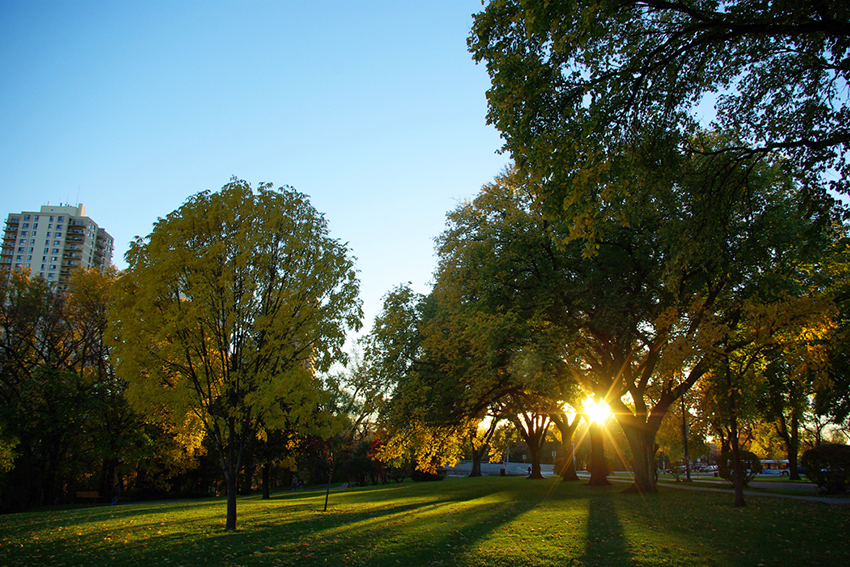By Brent Bellamy, Creative Director and Architect


As Winnipeg's trees drop their leaves and brace themselves for another winter, the full effects of the city's tireless battle against Dutch elm disease has revealed itself once again. Trees resigned to their ultimate fate wear an orange dot of paint like a scarlet letter, and significant gaps can now be seen in the once-continuous tree canopy that rises above many of the city's neighbourhoods.
In 1900, Winnipeg's civic leaders decided that to elevate the image of their gritty, featureless prairie town, residential streets should be built with boulevards and lined with grand trees. The American elm was the species of choice because it was beautiful, resilient and readily available to be transplanted from the city's riverbanks.
That forward-thinking decision has defined the image of Winnipeg for more than a century. The quality of light filtered through a cathedral arch of 25-metre-high elm trees is a uniquely Winnipeg experience. These trees today form the backbone of an impressive urban forest, one of the city's truly special attributes.
Looking beyond esthetics, cities across North America have begun to study the value of their urban forests as a tool to inform the political policy and public investment that guides the civic economy and environment.
The City of Toronto released a detailed study in 2013 entitled Every Tree Counts. In this document, all impacts of the city's urban forest were considered with dollar values assigned to each. Its findings might be helpful to draw general conclusions about the value of Winnipeg's urban forest. By comparison, there are eight million trees on public and private land in Winnipeg, while Toronto, a city of twice the urban area, is home to 10 million trees.
The Toronto study begins by simply calculating the structural value of the forest itself, by assigning an average cost of $700 for each tree to be removed and replaced. The value for the city's 10 million trees was then calculated to be $7 billion. An extrapolation of this cost would mean a structural value of $5.6 billion for Winnipeg's trees.
Beyond their worth as a commodity, social and environmental benefits were also identified. Each year, Toronto's trees absorb 25 million cubic metres of water from precipitation. Intercepting water before it is absorbed into the ground relieves pressure on sewer infrastructure, saving the city an estimated $54 million per year in maintenance costs. With Winnipeg's combined sewer system in many older neighbourhoods, the importance of water absorption, particularly from large boulevard trees, brings an increased value by protecting homes from backup storm flooding.
An urban forest improves air quality by producing oxygen and absorbing pollutants. Toronto's trees absorb an amount of pollution equal to that released by one million cars annually. Disregarding the health effects this pollution would have on the population, the simple cost for Toronto to remove that amount of pollutants mechanically from the air would be $19 million per year.
As trees grow, they remove carbon from the atmosphere and store it in their woody tissues. This means an urban forest plays an important role in reducing a city's carbon emissions and contribution to climate change. It is believed Toronto's trees store the equivalent amount of carbon emitted from 750,000 vehicles every year. Tree shading moderates the city's microclimate, which also reduces greenhouse gas emissions by lower energy consumption for the mechanical cooling of buildings.
In total, Toronto's 10 million trees represent $80 million in environmental services and infrastructure cost savings to the city every year. These benefits are bolstered by increased property values and in turn taxes, typically found in areas with more trees.
A secondary study recently released, Neighbourhood Greenspace and Health in a Large Urban Centre, found the social impact of Toronto's urban forest is also significant. The study surveyed 31,000 people in different neighbourhoods, asking them to assess their perceived state of health, including conditions such as high blood pressure, obesity, heart disease and diabetes. The results were overlaid on tree maps and it was discovered having 10 or more mature trees on your block has the equivalent self-reported health benefits of a $10,000 salary increase, or moving to a neighbourhood with a $10,000 higher median income, or even being seven years younger. People in poorer areas with plentiful trees reported health that more closely resembled affluent neighbourhoods, and those living on wealthier streets without trees reported health similar to that of people in poorer communities.
The social, environmental and economic benefits of a city's urban forest have led Toronto to establish an aggressive goal of doubling its tree canopy over the next 40 years. To achieve this, it has committed to planting 100,000 trees per year in the city. By comparison, a good year in Winnipeg would see the city replace about 2,000 trees, a fraction of the 4,000 to 6,000 elm trees alone that are lost each year.
Winnipeg has been a leader in the preservation of its urban forest. Without a dedicated effort to reduce the effects of Dutch elm disease, it is believed the city would have lost its last elm tree in 2002, yet today the city is still home to the world's largest urban elm collection.
It is impossible to imagine Winnipeg without its majestic tree canopy, but even if aggressive replanting strategies were implemented, it will not look the same to future generations. An emphasis on diversifying the species mix means the distinctive homogenous canopy will be lost as elm numbers depreciate.
Cars also affect the look of the tree canopy, as new safety regulations dictate where trees can be planted to accommodate higher vehicle speeds. Road salt, snow clearing and pollution will also likely prevent new trees from reaching the heights of those planted a century ago. Preservation is the only option if we want to maintain the dramatic look of our current tree canopy as much as possible.
Protecting our urban forest is difficult for a cash-strapped civic government. Even with a deeper understanding of the urban forest's impact on the city, program funding decreased this year. The collective annual government investment is consistently far less than the monetary value and economic benefit of the asset. Advocates are calling for greater provincial involvement to fill the funding gaps, incentivize private-land tree planting and reinstate vital buffer-zone management areas encircling the city to keep new and existing diseases from spreading.
We know trees are beautiful, but as we begin to further understand their economic and social impact on cities, it is becoming even more important to continue the fight to preserve our urban forest. The challenge is one that must be met through elevated commitment by government and private landowners, working together to protect the city's most valuable, elegant and irreplaceable asset.
Brent Bellamy is creative director at Number Ten Architectural Group.
bbellamy@numberten.com
Republished from the Winnipeg Free Press print edition November 2, 2015 B6

